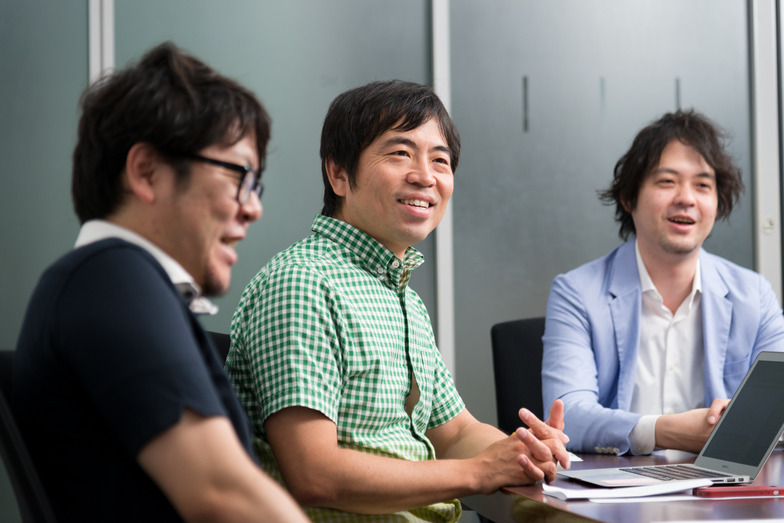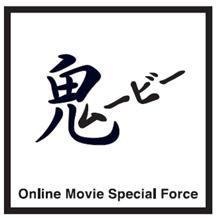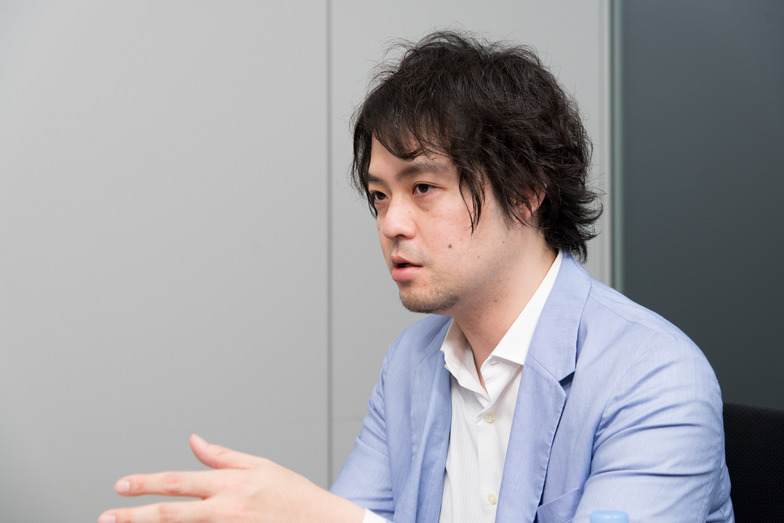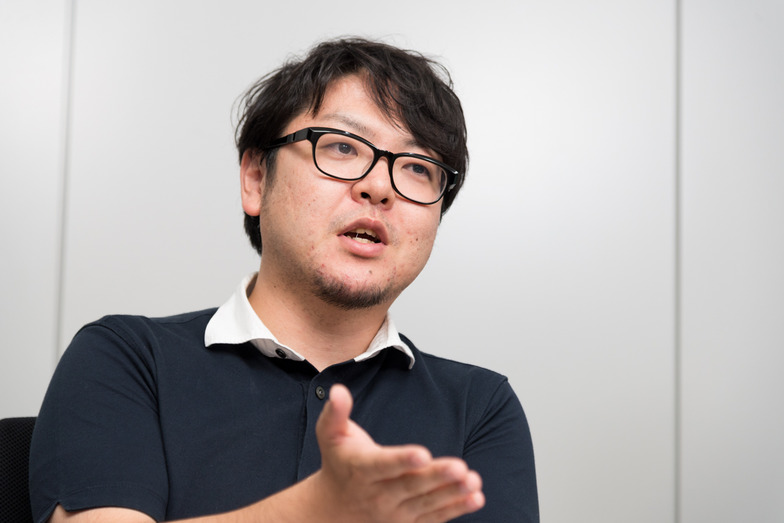Video viewing on the internet is rapidly permeating our lives. The online video market is expanding rapidly within Japan, drawing intense attention from advertisers. Riding this wave, Dentsu Inc. has launched "Oni Movie," a specialized team for online video production. This cross-departmental team, comprising experts in creative, media, and PR, will pursue online videos that move consumers. We spoke with Yasuharu Sasaki, Executive Creative Director serving as the team's leader; Tenpei Shikama, a digital media professional involved in the project; and Yohei Nemoto, a PR consultant, about the background behind this team launch and their future outlook.

Yohei Nemoto (left), Yasuharu Sasaki (center), Tenpei Shikama (right)
What is "Oni Movie"?
A cross-functional organization launched by the Dentsu Group in response to the expanding online video market and growing advertiser demand. Comprising approximately 30 members, it includes creators with extensive online video production experience, media specialists with deep knowledge of media utilization and user insights, and PR experts skilled in designing PR campaigns that spread organically among consumers. While positioning online video as a new tool for solving corporate challenges, the team will also explore media development and the future of content. Incidentally, the "Oni" (鬼) in the name was proposed by members in their 20s. It incorporates the term "Oni" ("鬼"), commonly used by the younger generation who casually enjoy online videos in phrases like "Oni-yabai" ("Oni-crazy") or "Oni-nakeru" ("Oni-crying"), signifying a team that creates "Oni-○○" videos.
~From a Creative Perspective~
Moving Digital-Age Users
Yasuharu Sasaki
Executive Creative Director, Dentsu Inc. CDC

In online video, this year's Cannes Lions saw a symbolic event. U.S. auto insurer GEICO turned the characteristic of video ads—that they can be skipped after 5 seconds—on its head by creating an ad where the main message ended within 5 seconds. This won the Grand Prix in the Film category. It made me realize online video has reached such a bright place—where, with the right approach, everyone will watch. In fact, videos exceeding 100 million views are starting to appear, thanks to effectively engaging viewers and moving them emotionally.
In the vast online space, the default assumption for online video is that it won't be seen. This is a major difference from traditional mass advertising, like TV commercials, which are more likely to be seen as part of people's media consumption flow. It's not simply about having more places to run ads or being able to show more products in longer formats. You need to think about how to make people think, "Well, maybe I'll give it a look." Overseas, they understand this. Examples like the "First Kiss" ad by the American apparel brand wren, which won an award at Cannes last year, are emerging. These ads achieve high engagement by creating content that taps into what people emotionally desire or resonates with their message, without any product explanation whatsoever, and brilliantly translate that into sales.

Even within the same video ad format, if the way it's received changes, the content itself naturally needs to be different. For instance, what kind of video would be acceptable when you're casually browsing your smartphone just before falling asleep at night? Perhaps something slightly heartwarming, even if it might feel a bit embarrassing to watch with family. At the very least, delivering a loud corporate product pitch seems unlikely to succeed. Or, whether the ad is on LINE or on Google, where the purpose is information gathering, also changes how it's received. Understanding that distance is crucial.
In the ever-expanding online space, relying solely on expression or media has its limits. For this "Oni Movie" project, members who have explored how to move users' emotions in the digital realm across various fields came together, united by the belief that pooling our insights could create something more interesting and powerful. The response has been tremendous since its inception, with about 30 members already working at full capacity.
I feel we are now at a moment as important as when TV commercials were first born. We want to invent new ways to connect users and brands, become a place where clients truly believe video ads work, and a place where high-quality creative challenges can be undertaken. Getting our busy members together is extremely difficult, but we want to keep our efforts focused and cohesive.
~From a Media Perspective~
Creating the Future of Video Together with Media
Tenpei Shikama
Interactive Producer, MC Planning Bureau, Dentsu Inc.
For some time now, we've been hearing that the era of video has arrived, and now it's finally becoming a certainty. With the proliferation of smartphones and improved connectivity, virtually all content is now being produced as video. New media platforms are emerging one after another, and user-generated content has become commonplace. I truly feel the time is ripe.
This spring, I attended the "Digital Content NewFronts" in New York City. Originally modeled after the "Upfronts" where TV networks present their upcoming season's programming to sell advertising slots in advance, this event began in 2008 as a showcase for digital media. It featured not only digital platforms like Yahoo!, YouTube, and Hulu, but also major US newspapers like The New York Times and The Wall Street Journal, Condé Nast magazines, and Bloomberg financial information. They all simultaneously showcased original online video content of such high quality that it rivaled television programming. I was astonished to see how rich and substantial online content has already become, both in quantity and quality.
Moreover, this content is valued as having the same worth regardless of the device or location it's viewed on, transcending traditional media boundaries. The same applies to its advertising space. While Japan and the US have fundamentally different environments, so they won't necessarily follow the exact same path, trends like the strengthening push for joint catch-up streaming by Japanese commercial broadcasters and Netflix's announcement of focusing on original content development indicate that so-called premium video content is starting to increase online in Japan too. I feel the tide has finally turned significantly.
Alongside this penetration of video content, it's becoming increasingly important to move beyond the mindset of simply "going viral" and instead assess whether a video truly captures and moves consumers' hearts, and whether it contributes to solving the core communication challenges.
However, there is no single correct approach here. New technologies and media emerge daily, making the development of video creatives to solve specific challenges and the creation of distribution strategies using new media akin to searching for the right answer among infinite possibilities.
That's precisely why I believe it's entirely possible to create unexpected new ways of communicating or even develop the media itself by working as a team with professionals who bring different perspectives, rather than just thinking about how to use existing advertising slots.
It's often confused, but video itself isn't a medium; it's merely a format. With digitalization, video is permeating every aspect of life. It might not be Harry Potter, but in the not-too-distant future, videos could play in newspapers. Or perhaps videos viewed up close, like holograms on wearable devices, could become commonplace. Naturally, this opens up tremendous possibilities for the advertising that unfolds there.
This is why "Oni Movie" was launched: to bring together professionals from diverse fields once again, to explore anew "the future of video." While specialization can be efficient in traditional media where expertise is accumulated, similarly, focusing solely on video "advertising" at this stage risks narrowing the perspective, often fixating solely on cost efficiency. Our team's greatest strength lies in its ability to identify new possibilities for "video" by taking a holistic view of communication and incorporating perspectives from multiple specialized fields. We aim to pioneer uncharted territory, hand-in-hand with media companies, as a place where everyone can dream—much like the American Dream. We believe this is our team's mission.
~From a PR Perspective~
Designing information distribution channels and aligning them with consumers' contexts to foster personal relevance
Yohei Nemoto
Senior Consultant, Communication Design Division, Dentsu Inc. Public Relations
Video is becoming the default medium even in PR. I believe visuals have the power to convey more information intuitively than text or still images. At the same time, I sense the barriers to producing, publishing, and distributing videos have become incredibly low. This aligns with the current trend of brand journalism, where companies themselves become media outlets, creating content that resonates with their audience. Consequently, I anticipate an increase in information dissemination through easily spreadable video formats, and their importance will only grow.
Figuring out how to get people to watch online videos, which inherently start with little reach, is actually quite close to what we've always done. PR firms might be strongly associated with just pushing information out, but PR is an abbreviation for Public Relations. It's not just one-way communication; it's a strategic communication process about building mutual relationships, like shaping public opinion and forming consensus. One of our core competencies is crafting high-value information with perspectives that make media and consumers "want to talk about it." Therefore, online video, which operates close to consumers, shares affinity with us in the perspective of aligning with consumer contexts and making content feel personally relevant.
We increasingly receive requests simply to "make something go viral." While we should clarify whether "going viral" is the goal or merely a means, if aiming for "buzz," waiting for chance alone won't get you started.
There's a reason things go viral. By researching and analyzing what's trending in the world, we believe we can strategically design what kind of content, where to ignite it, and how it will spread.
When considering what resonates with consumers, it's crucial to examine whether the "vehicle" (i.e., content) is compelling, the "boarding point" (i.e., media) is distinctive, or the "route" (i.e., information distribution channel) is effective. Is it a car, plane, truck, or sports car? Does it depart from Haneda or Tokyo Station? Does it take the expressway or regular roads? We must consider the optimal method to reach consumers.
With the launch of "Oni Movie," we now have an environment where creative, media, and PR can plan together from the very start at one table. This makes finding this "optimal method" much easier. While communication objectives vary—such as improving favorability or awareness, or building engagement—having all three parties think together from the beginning enables the design of more effective creative and information pathways.
Furthermore, I feel it's crucial to accumulate insights in one place to take further steps in responding to the ever-changing world and media trends.
Right now, I feel we're at the moment where video as a format is becoming something new. Whether that's a market, a medium, or a style, I'm not sure, but I want to make "Oni Movie" a model case for that.















